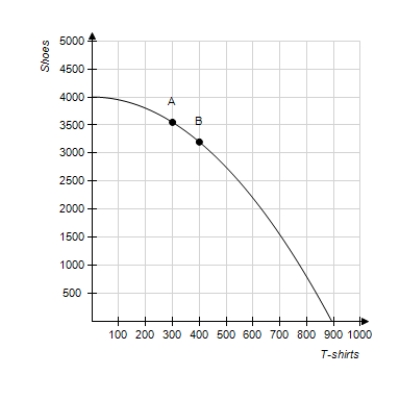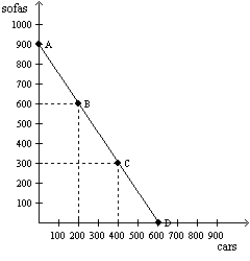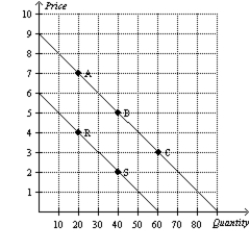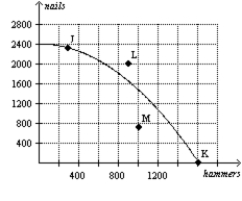A) was created in 1946.
B) advises the president of the United States on economic policy matters.
C) writes the annual Economic Report of the President.
D) All of the above are correct.
F) B) and C)
Correct Answer

verified
Correct Answer
verified
Multiple Choice
The production possibilities frontier provides an illustration of the principle that
A) trade can make everyone better off.
B) governments can sometimes improve market outcomes.
C) people face trade-offs.
D) people respond to incentives.
F) A) and D)
Correct Answer

verified
Correct Answer
verified
Multiple Choice
Yi and Avik are both economists. Yi thinks that taxing consumption, rather than income, would result in higher household saving because income that is saved would not be taxed. Avik does not think that household saving would respond much to a change in the tax laws. In this example, Yi and Avik
A) hold different normative views about the tax system.
B) disagree about the validity of a positive theory.
C) have a fundamental misunderstanding of the tax system.
D) More than one of the above is correct.
F) B) and C)
Correct Answer

verified
Correct Answer
verified
True/False
Figure 2-17  -Refer to Figure 2-17. It is possible for this economy to produce 1000 shoes.
-Refer to Figure 2-17. It is possible for this economy to produce 1000 shoes.
B) False
Correct Answer

verified
Correct Answer
verified
True/False
A production possibilities frontier will be bowed outward if some of the economy's resources are better suited to producing one good than another.
B) False
Correct Answer

verified
Correct Answer
verified
Multiple Choice
In the simple circular-flow diagram, the participants in the economy are
A) firms and government.
B) households and firms.
C) households and government.
D) households, firms, and government.
F) A) and D)
Correct Answer

verified
Correct Answer
verified
Multiple Choice
The most common data for testing economic theories come from
A) carefully controlled and conducted laboratory experiments.
B) computer models of economies.
C) historical episodes of economic change.
D) centrally planned economies.
F) None of the above
Correct Answer

verified
Correct Answer
verified
Multiple Choice
Figure 2-15  -Refer to Figure 2-15. Consider the production possibilities frontier for an economy that produces only sofas and cars. When society moves from point A to point B,
-Refer to Figure 2-15. Consider the production possibilities frontier for an economy that produces only sofas and cars. When society moves from point A to point B,
A) the opportunity cost is the same as when society moves from point B to point C.
B) it is giving up cars to get sofas.
C) the opportunity cost is increasing.
D) it moves from an inefficient point to an efficient point.
F) B) and C)
Correct Answer

verified
Correct Answer
verified
Short Answer
Figure 2-22  -Refer to Figure 2-22. Given that price is measured on the vertical axis, quantity is measured on the horizontal axis, and that the curves are downward-sloping, what type of curves are depicted here?
-Refer to Figure 2-22. Given that price is measured on the vertical axis, quantity is measured on the horizontal axis, and that the curves are downward-sloping, what type of curves are depicted here?
Correct Answer

verified
Correct Answer
verified
Multiple Choice
Which of the following is an example of a capital input?
A) a computer
B) a share of stock
C) an hour of a worker's time
D) $50,000
F) B) and C)
Correct Answer

verified
Correct Answer
verified
Multiple Choice
Which of the following statements about economic models is correct?
A) Economic models are built to mirror reality exactly.
B) Economic models are useful, but they should not be used for the purpose of improving public policies.
C) Because economic models omit many details, they allow us to see what is truly important.
D) Economic models seldom incorporate equations or diagrams.
F) None of the above
Correct Answer

verified
Correct Answer
verified
True/False
When a production possibilities frontier is bowed outward, the opportunity cost of the first good in terms of the second good increases as more of the second good is produced.
B) False
Correct Answer

verified
Correct Answer
verified
Short Answer
Most economists agree that a large federal budget deficit has what type of effect on the economy?
Correct Answer

verified
Correct Answer
verified
Multiple Choice
In the markets for factors of production in the circular-flow diagram,
A) households provide firms with labor, land, and capital.
B) households provide firms with savings for investment.
C) firms provide households with goods and services.
D) firms provide households with revenue.
F) A) and B)
Correct Answer

verified
Correct Answer
verified
True/False
Economists devise theories, collect data, and then analyze these data in an attempt to verify or refute their theories.
B) False
Correct Answer

verified
Correct Answer
verified
Multiple Choice
Figure 2-8  -Refer to Figure 2-8. To reach point L, the economy would have to
-Refer to Figure 2-8. To reach point L, the economy would have to
A) acquire more resources or experience a technological advance.
B) begin using its available resources more efficiently than it is currently using them.
C) shift resources away from the production of nails and toward the production of hammers.
D) None of the above are correct; the economy will never be able to reach point L.
F) None of the above
Correct Answer

verified
Correct Answer
verified
True/False
In the circular-flow diagram, factors of production are the goods and services produced by firms.
B) False
Correct Answer

verified
Correct Answer
verified
Multiple Choice
Some, but not all, government economists are employed within the administrative branch of government. Which of the following government agencies employs economists outside of the administrative branch?
A) the Department of Labor
B) the Department of the Treasury
C) the Congressional Budget Office
D) the Council of Economic Advisers
F) A) and B)
Correct Answer

verified
Correct Answer
verified
True/False
In the circular-flow diagram, firms produce goods and services using the factors of production.
B) False
Correct Answer

verified
Correct Answer
verified
True/False
When two variables move in opposite directions, the curve relating them is upward sloping, and we say the variables are positively related.
B) False
Correct Answer

verified
Correct Answer
verified
Showing 581 - 600 of 645
Related Exams